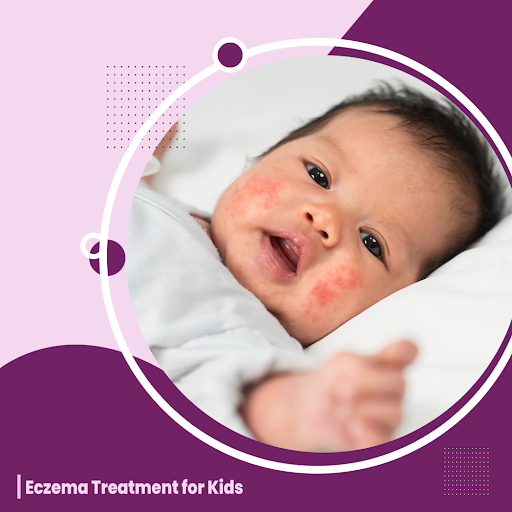Eczema Treatment for Kids:
What Is Eczema?
Eczema is a condition where the skin gets irritated, red, dry, bumpy and itchy. There are some types of eczema, but the most general is atopic dermatitis.
What Are the Signs & Symptoms of Eczema?
- Are mainly dry, itchy skin. Because it is so itchy, it is often called "the itch that rashes."
- include redness, scales, and bumps that can leak fluid and then crust over
- Tend to come and go. When they get worse, it is called a flare-up.
- may be more noticeable at night

How Is Eczema Diagnosed?
There is no particular test used to analyze eczema. The specialist will check out the rash and get some information about manifestations, the child’s previous wellbeing, and the family's wellbeing. If relatives have any atopic conditions, that is a significant piece of information. The specialist will preclude different conditions that can cause skin aggravation, and might suggest that your child should see a skin specialist or an allergist. The specialist might request that you avoid a few food varieties (like eggs, milk, soy, or nuts) from your child’s diet, switch cleansers or cleansers, or roll out different improvements so that a period could check whether your kid is responding to something.
There are three things that help just about everybody.
- Moisturize:
- Bleach showers:
- Wet wraps:
This might appear glaringly evident; With regards to picking a lotion, think greasy when eczema gets intense. This sort of moisturizer is called an emollient. Indeed, even petrol jam, or hydrated petrolatums, which are both generally accessible, can truly help dry, aggravated skin. And keeping in mind that they feel greasy when you put them on, generally the skin douses them straight up. Applying emollients a few times each day can truly help when circumstances become difficult and can also assist with keeping eczema from erupting.
This doesn’t mean sitting a child in a tub of fade, which would be a poorly conceived notion. What it implies is making the water in the tub similar to the chlorinated water in a pool. The sanitizer assists with killing microorganisms on the skin, and furthermore assists with irritation. Add a large portion of some sanitizer (standard family blanch, not concentrated) for a full tub of water, or a quarter cup for a large portion of a tub. The water ought to be warm yet not hot, as high temp water can dry out the skin. Drench for around 10 minutes, wash off, and wipe off, not rub dry. A few times each week is typically two or three times. Check with your PCP before you begin, to be certain it’s a smart thought for your child and to choose how frequently you ought to get it done.
You wouldn’t ordinarily consider taking care of your child with wet night wear, yet in some cases doing only that can help eczema by keeping the skin wet. Utilize long clothing or other tight night wear. You need to cover the area that is generally impacted. If the eczema is simply on the arms, utilizing tube socks with the feet cut off can also work and for babies, a moisturizer can do the trick too. Hose the night wear with warm water and wring them out so they aren’t trickling, and afterward put them on (subsequent to applying creams and lotion), with dry nightgown over them. You can put a towel on the bed to hold it back from getting sodden while the moisture dissipates and the night robe dry.

